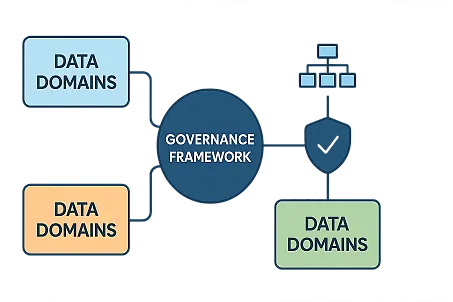Data domain mapping is often the silent saboteur of enterprise data governance programs. At first glance, defining domains seems like child’s play – just drawing boxes around related data. Yet when domains remain undefined or poorly mapped, governance efforts stall and falter. Many organizations overlook this critical foundation, and their governance initiatives suffer as a result.
When data domains are undefined, confusion reigns: no one is sure who owns what data, and governance can grind to a halt. Teams lack clarity on scope and responsibilities, making it nearly impossible to enforce policies or improve data quality. The remedy lies in organizing data into logical domains. Establishing clear domain groupings with assigned owners jumpstarts governance by bringing structure and accountability to an otherwise chaotic data landscape.
Key Benefits of Data Domain Mapping
-
Logical Groupings Simplify the Data Catalog: Data domains group related data logically, acting like large sections in a library for your enterprise information linkedin.com. By separating data into domains (often aligned to business functions like Finance, HR, Sales), you bring order to sprawling datasets rittmanmead.com. This logical grouping simplifies your data catalog structure, making it easier for users to find what they need rittmanmead.com. In short, domains provide a clear, high-level structure for otherwise siloed or disorganized data collections linkedin.com.
-
Clear Ownership and Accountability: Each domain is aligned with a specific business unit or function, which means that unit takes ownership of “its” data linkedin.com. This alignment establishes clear accountability. For example, the finance team owns finance data, the sales team owns sales data, and so on getdbt.com. Assigning domains by business area ensures that subject-matter experts are responsible for data quality and definitions in their domain rittmanmead.com. With designated domain owners, there’s no ambiguity about who manages and governs a given dataset – stewardship is baked in.
-
Beware the Hidden Complexity: Mapping data domains is not as easy as drawing boxes on an org chart. In fact, it’s one of the most underestimated challenges in data governance linkedin.com. Defining the right scope and boundaries for each domain – and getting consensus across departments – can take months of effort linkedin.com. What looks simple on paper often grows complicated in practice, as teams debate overlaps and definitions. It’s critical to recognize this hidden complexity early. Underestimating it can derail your governance program, turning a “beautiful idea on paper” into frustration linkedin.com. Patience and careful planning are required to navigate the domain mapping maze of decisions.
-
Scoped Governance for Quick Wins: The beauty of domain-driven mapping is that it lets you tackle data governance in manageable chunks. Rather than boiling the ocean, you can prioritize one or two domains to begin governance initiatives on a smaller, controlled scope linkedin.com. Focusing on a high-value domain (say, customer or finance data) allows you to implement policies, data quality checks, and catalogs in that area first, delivering quick wins to the business. This domain-by-domain approach is “elegant [and] manageable”linkedin.com – it builds momentum. By demonstrating success in a well-chosen domain, you create a template that can be rolled out to other domains over time. This incremental strategy prevents overwhelm and proves the value of governance early on.
-
Improved Discoverability and Team Autonomy: Organizing by data domains doesn’t just help users find data – it also empowers teams. A domain-oriented data architecture enhances discoverability by grouping data that naturally belongs together, allowing data consumers to know where to look. Moreover, because each domain team manages its own data assets, they gain greater autonomy to innovate within their realm. Modern decentralized data frameworks (like data mesh) highlight that giving domain teams ownership leads to faster, more tailored solutions – with data made “easily consumable by others” across the organization getdbt.com. Teams closest to the data have the freedom to adapt and improve it, while enterprise-wide standards provide governance guardrails. In other words, domain mapping enables a balance: local autonomy for domain teams within a framework of central oversight. Federated governance models ensure that even as teams operate independently, they adhere to common policies and compliance requirements getdbt.com. The result is a more agile data environment where information is both discoverable and well-governed.
Conclusion – Structure for Success: Logical domain structures ultimately drive trust in data. When everyone knows where data lives and who stewards it, confidence in using that data soars. Clarity in domain ownership and scope unlocks fast governance wins by allowing focused improvements. In essence, the right structure silences the “silent saboteur” that undermines so many governance efforts. By mapping your domains, you take control of your data – and set the stage to master it.
Sources:
-
Charlotte Ledoux, “The Data Domains Map Enigma” – LinkedIn Post linkedin.com
-
Jon Mead, “How to Get a Data Governance Programme Underway... Quickly” – RittmanMead Blog rittmanmead.com rittmanmead.com
-
Daniel Poppy, “The 4 Principles of Data Mesh” – dbt Labs Blog getdbt.com getdbt.com
-
Daniel Poppy, “The 4 Principles of Data Mesh” (Federated Governance) – dbt Labs Blog getdbt.com
